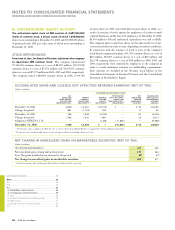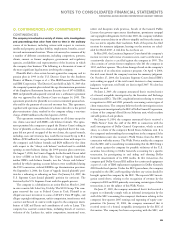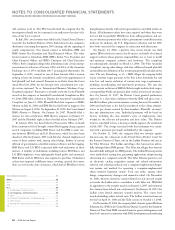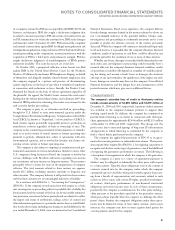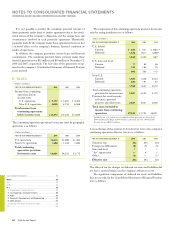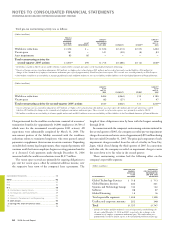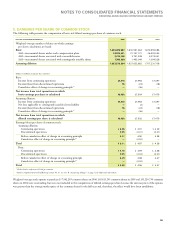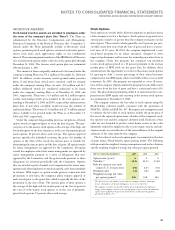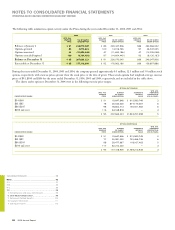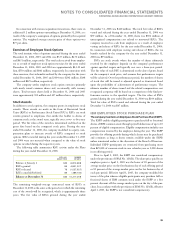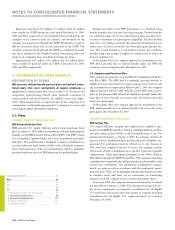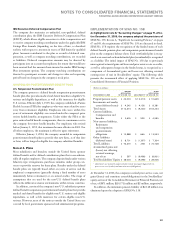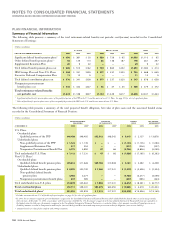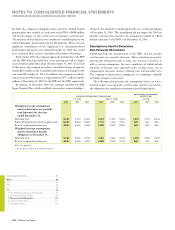IBM 2006 Annual Report Download - page 99
Download and view the complete annual report
Please find page 99 of the 2006 IBM annual report below. You can navigate through the pages in the report by either clicking on the pages listed below, or by using the keyword search tool below to find specific information within the annual report.
Black
MAC
390 CG10
NOTES TO CONSOLIDATED FINANCIAL STATEMENTS
INTERNATIONAL BUSINESS MACHINES CORPORATION AND SUBSIDIARY COMPANIES
97
INCENTIVE AWARDS
Stock-based incentive awards are provided to employees under
the terms of the company’s plans (the “Plans”). The Plans are
administered by the Executive Compensation and Management
Resources Committee of the Board of Directors (the “Committee”).
Awards under the Plans principally include at-the-money stock
options, premium-priced stock options, restricted stock units, perfor-
mance stock units, stock appreciation rights or any combination
thereof. The nonmanagement members of the IBM Board of Directors
also received stock options under a director stock option plan through
December 31, 2006. The director stock option plan was terminated
effective January 1, 2007.
The amount of shares originally authorized to be issued under the
company’s existing Plans was 274.1 million at December 31, 2006 and
2005. In addition, certain incentive awards granted under previous
plans, if and when those awards were canceled, could be reissued
under the company’s existing Plans. As such, 45.9 million and 44.7
million additional awards are considered authorized to be issued
under the company’s existing Plans as of December 31, 2006 and
2005, respectively. There were 51.6 million and 66.2 million option
awards outstanding (which were included in the total options out-
standing at December 31, 2006 and 2005, respectively) under previous
plans that, if and when cancelled, would increase the number of
authorized shares. There were 131.8 million and 127.4 million unused
shares available to be granted under the Plans as of December 31,
2006 and 2005, respectively.
Under the company’s long-standing practices and policies, all stock
option awards are approved prior to or on the date of grant. The exer-
cise price of at-the-money stock options is the average of the high and
low market price on the date of grant or, in the case of premium-priced
stock options, 10 percent above such average. The options approval
process specifies the individual receiving the grant, the number of
options or the value of the award, the exercise price or formula for
determining the exercise price and the date of grant. All option awards
for senior management are approved by the Committee. All option
awards for employees other than senior management are approved by
senior management pursuant to a series of delegations that were
approved by the Committee, and the grants made pursuant to these
delegations are reviewed periodically with the Committee. Options
that are awarded as part of annual total compensation for senior man-
agement and other employees are made on specific cycle dates scheduled
in advance. With respect to option awards given in connection with
promotions or new hires, the company’s policy requires approval of
such awards prior to the grant date, which is typically the date of the
promotion or the date of hire. The exercise price of these options is
the average of the high and low market price on the date of grant in
the case of at-the-money stock options or, in the case of premium-
priced stock options, 10 percent above such average.
Stock Options
Stock options are awards which allow the employee to purchase shares
of the company’s stock at a fixed price. Stock options are granted at an
exercise price equal to or greater than the company stock price on the
date of grant. These awards, which generally vest 25 percent per year,
are fully vested four years from the date of grant and have a contrac-
tual term of 10 years. In 2004, the company implemented a new
stock-based program for its senior executives, designed to drive
improved performance and increase the ownership executives have in
the company. Under this program, the company’s top executives
receive stock options priced at a 10 percent premium to the average
market price of IBM stock on the grant date. In addition, these
executives have the opportunity to receive at-the-money stock options
by agreeing to defer a certain percentage of their annual incentive
compensation into IBM equity, where it is held for three years or until
retirement. In 2005, this program was expanded to cover all execu-
tives of the company. Options under this program become fully vested
three years from the date of grant and have a contractual term of 10
years. The plan element permitting deferral of annual incentive com-
pensation into IBM equity and receiving at-the-money stock options
was terminated at December 31, 2006.
The company estimates the fair value of stock options using the
Black-Scholes valuation model, consistent with the provisions of
SFAS No. 123(R) and SAB No. 107. Key inputs and assumptions used
to estimate the fair value of stock options include the grant price of
the award, the expected option term, volatility of the company’s stock,
the risk-free rate and the company’s dividend yield. Estimates of fair
value are not intended to predict actual future events or the value
ultimately realized by employees who receive equity awards, and sub-
sequent events are not indicative of the reasonableness of the original
estimates of fair value made by the company.
The fair value of each stock option grant was estimated at the date
of grant using a Black-Scholes option pricing model. The following
table presents the weighted-average assumptions used in the valuation
and the resulting weighted-average fair value per option granted:
FOR THE YEAR ENDED DECEMBER 31: 2006 2005 2004
Option term (years)*
Volatility** .% .% .%
Risk-free interest rate (zero
coupon U.S. treasury note) .% .% .%
Dividend yield .% .% .%
Weighted-average fair value
per option granted $ $ $
* The Option term is the number of years that the company estimates, based upon
history, that options will be outstanding prior to exercise or forfeiture.
** The company’s estimates of expected volatility are principally based on daily price
changes of the company’s stock over the expected option term, as well as the additional
requirements included in the provisions of SFAS No. 123( R) and the guidance
provided by SAB No. 107.



